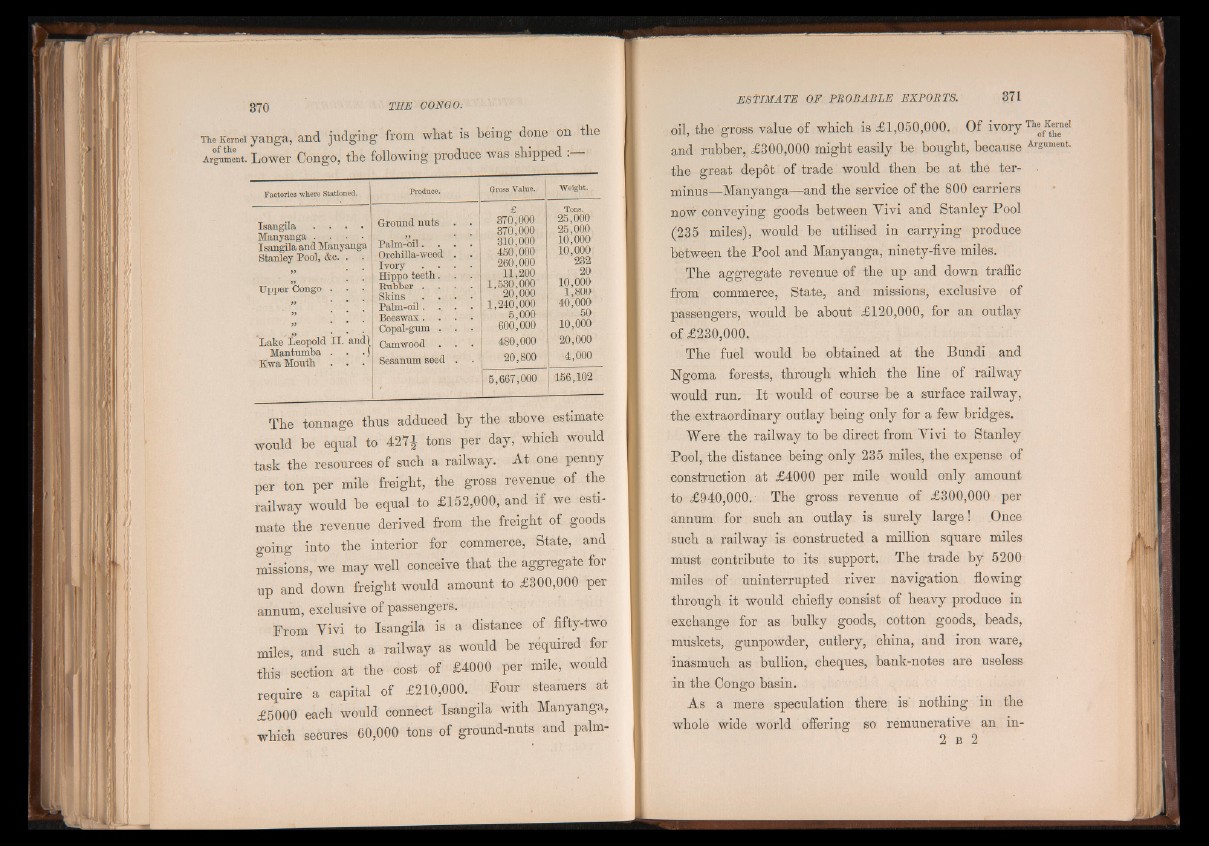
The Kernel yanga, and judging from what is being done on the
Argument. Lower Congo, the following produce was shipped .
Factories where Stationed. Produce. Gross Value. Weight.
Isangila . . . .
Manyanga . . . .
Isangila and Manyanga
Stanley Pool, &c. .
>>
JJ
Upper Congo . . •
Lake Leopold II. and)
Mantumba . . ■ f
Kwa Montb . • •
Ground nuts . .
)} * *
Palm-'oil. . . .
Orehilla-weed . .
Ivory . . . .
Hippo teeth. . .
Rubber .
Skins . . . .
Palm-oil. . . •
Beeswax . . . .
Copal-gum . . .
Camwood .
Sesanum seed .
£
370.000
370.000
310,000
450.000
260.000
11,200
1.530.000
20,000
1.240.000
5,000
600,000
480,000
20,800
Tons.
25.000
25.000
10.000
10,000
232
20
10,000
1,800
40.000
1 50
10.000
20,000
4,000
5,667,000 156,102
The tonnage thus adduced by the above estimate
would he equal to 427^ tons per day, which would
task the resources of such a railway. At one penny
per ton per mile freight, the gross revenue of the
railway would be equal to £152,000, and if we esti
mate the revenue derived from the freight of goods
going into the interior for commerce, State, and
missions, we may well conceive that the aggregate foi
up and down freight would amount to £300,000 per
annum, exclusive of passengers.
From Vivi to Isangila is a distance of fifty-two
miles, and such a railway as would be required for
this section at the cost of £4000 per mile, would
require a capital of £210,000. Four steamers at
£5000 each would connect Isangila with Manyanga,
which secures 60,000 tons of ground-nuts and palme
s Tim a t e o f p r o b a b l e e x p o r t s . 371
oil, the gross value of which is £1,050,000. Of ivory Th®fKt^™el
and rubber, £300,000 might easily he bought, because Argument-
the great dépôt of trade would then he at the ter-
minus—Manyanga—and the service of the 800 carriers
now conveying goods between Yivi and Stanley Pool
(235 miles), would be utilised in carrying produce
between the Pool and Manyanga, ninety-five miles.
The aggregate revenue of the up and down traffic
from commerce, State, and missions, exclusive of
passengers, would be about £120,000, for an outlay
of £230,000.
The fuel would he obtained at the Bundi and
Mgoma forests, through which the line of railway
would run. I t would of course he a surface railway,
the extraordinary outlay being only for a few bridges.
Were the railway to he direct from Yivi to Stanley
Pool, the distance being only 235 miles, the expense of
construction at £4000 per mile would only amount
to £940,000. The gross revenue of £300,000 per
annum for such an outlay is surely large ! Once
such a railway is constructed a million square miles
must contribute to its support. The trade by 5200
miles of uninterrupted river navigation flowing
through it would chiefly consist of heavy produce in
exchange for as bulky goods, cotton goods, beads,
muskets, gunpowder, cutlery, china, and iron ware,
inasmuch as bullion, cheques, bank-notes are useless
in the Congo basin.
As a mere speculation there is’ nothing in the
whole wide world offering so remunerative an in-
2 b 2